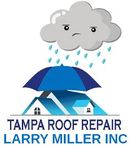Serving Tampa and Surrounding Areas
Serving Tampa and Surrounding Areas
LARRY MILLER INC.
LARRY MILLER INC.
Roof Repair, Maintenance, and Roof Replacement in Brandon, FL
5% OFF for Veterans
24/7 Emergency Response
FREE Estimates
We Offer Financing
Request Call Back
Hero Request Form
Thank you for contacting us.
We will get back to you as soon as possible
Please try again later
Experience the Finest Roofing Services in Tampa, FL
Larry Miller Inc, a local, fourth-generation family-owned, and operated business, proudly offers Tampa and its neighboring areas exceptional roofing services. Our hands-on owner is your trusted point of contact for every project. Regardless of the season, you can rely on us for unwavering service and dependability.
Discover how our licensed and insured contractors can safeguard your property. Whether you need repairs, maintenance, or a full roof replacement in Brandon, FL, we can help! Don't hesitate to call us and inquire about our FREE estimates! Your peace of mind is our priority.
Why Choose Larry Miller Inc?
Larry Miller Inc
is your go-to place for premier roofing services! As a local and family-owned company, we take pride in delivering exceptional roofing solutions to our valued customers. With our competitive pricing, you can expect cost-effective services without compromising on quality. We understand the importance of prompt assistance, which is why we offer a next-day response to address your roofing needs promptly. To ensure your peace of mind, we provide a generous 7-year warranty on our work. Veterans deserve our gratitude, which is why we offer an exclusive 5% discount. Contact us today for a FREE estimate and experience the excellence of our roofing services. Se habla Español!
5% OFF for Veterans
Local and Family-Owned
Competitively Priced
Next Day Response
7-Year Warranty
FREE Estimates
Residential
With over 35 years of dedicated experience, Larry Miller Inc is your go-to expert for all your residential roofing needs. Our commitment to quality and customer satisfaction is unmatched.
Commercial
We specialize in assisting with a wide range of commercial roof concerns. Whether you're in need of a roof replacement, refurbishment, or regular maintenance, we've got you covered.
Shingle Roofing
Selecting the appropriate shingles for your residential roof can be a challenging task. Larry Miller Inc has a comprehensive guide that covers everything you need to know about shingle roof materials.
Roof Repair
Larry Miller Inc is your trusted roof repair specialist. Whether you're dealing with a minor leak or significant storm damage, our team is prepared to deliver the results you need. 24/7 emergency response is available.
Metal Roofing
Metal roofs installed by Larry Miller Inc demonstrate impressive resistance to fire, wind, and physical impact. We'll discuss all your choices for a metal roof and perform a flawless installation.
Roof Maintenance
Protect your roof and prevent ceiling leaks with our expert roof maintenance services by Larry Miller Inc. We offer top-notch services to ensure the durability of your roof throughout the year.
Rubber Roofing
Experience top-quality rubber roofing services with Larry Miller Inc. We're BBB A+ rated with over 35 years of experience, and we are your trusted experts in rubber roofing.
Roof Inspections
Ensure the longevity and reliability of your roof with our professional roof inspection service at Larry Miller Inc. Our team is available for 24/7 emergency response for any unexpected roofing issues.
Here's what our satisfied customers are saying...
At Larry Miller Inc, we take pride in providing exceptional roof contractors to our customers. We would be grateful if you could share your thoughts about our roofing business with others. Your feedback helps us improve, and helps others make informed decisions. Please take a moment to leave a review of Larry Miller Inc and let others know what you think.
Learn More About Larry Miller Inc
Serving the Tampa, FL area. Larry Miller Inc specializes in residential and commercial roofing and roof repair. 5% off for veterans. Competitively priced. Free estimates. Call us today.

Share On: